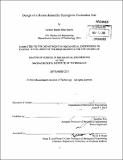| dc.contributor.advisor | Sangbae Kim. | en_US |
| dc.contributor.author | Graves, Carmen Marten-Ellis | en_US |
| dc.contributor.other | Massachusetts Institute of Technology. Department of Mechanical Engineering. | en_US |
| dc.date.accessioned | 2014-03-06T15:46:17Z | |
| dc.date.available | 2014-03-06T15:46:17Z | |
| dc.date.copyright | 2013 | en_US |
| dc.date.issued | 2013 | en_US |
| dc.identifier.uri | http://hdl.handle.net/1721.1/85497 | |
| dc.description | Thesis: S.M., Massachusetts Institute of Technology, Department of Mechanical Engineering, 2013. | en_US |
| dc.description | Cataloged from PDF version of thesis. | en_US |
| dc.description | Includes bibliographical references (pages 51-52). | en_US |
| dc.description.abstract | The focus of this thesis is on the design, development, and evaluation of a lightweight, exotendon suit for load carriage. The suit is intended to be worn underneath the wearer's own clothes for use in a military setting, while reducing the energy expenditure of the wearer. A simple exotendon suit architecture was designed and implemented, consisting of two knee braces, a length of polypropylene tendon, a belt, two electro-magnet clutches, and a control box. The electro-magnet clutches are mounted at the waist and tendons are used to apply the actuator's force to the wearer's ankles. This is advantageous, as many current exoskeletons mount actuators at the ankles, requiring a greater amount of additional energy expenditure. Testing was performed at the Wyss Institute for Biologically Inspired Engineering Motion Capture Laboratory. Metabolic power was tested using a COSMED K4b2 system and surface electromyogram (sEMG) data was collected using a Delsys Trigno system. Five male subjects participated in six trials, walking on a treadmill at 1.25 m/s, carrying a 20 kg load in a standard military rucksack. The six trials consisted of three conditions: street clothes, exosuit worn but unpowered (passive), and exosuit word and powered (active). Results of the tests were inconclusive. There was no significant evidence that powering the exosuit has a positive or negative effect on the wearer's energy usage. | en_US |
| dc.description.statementofresponsibility | by Carmen Marten-Ellis Graves. | en_US |
| dc.format.extent | 58 pages | en_US |
| dc.language.iso | eng | en_US |
| dc.publisher | Massachusetts Institute of Technology | en_US |
| dc.rights | M.I.T. theses are protected by copyright. They may be viewed from this source for any purpose, but reproduction or distribution in any format is prohibited without written permission. See provided URL for inquiries about permission. | en_US |
| dc.rights.uri | http://dspace.mit.edu/handle/1721.1/7582 | en_US |
| dc.subject | Mechanical Engineering. | en_US |
| dc.title | Design of a biomechanically synergistic exotendon suit | en_US |
| dc.type | Thesis | en_US |
| dc.description.degree | S.M. | en_US |
| dc.contributor.department | Massachusetts Institute of Technology. Department of Mechanical Engineering | |
| dc.identifier.oclc | 871002370 | en_US |
